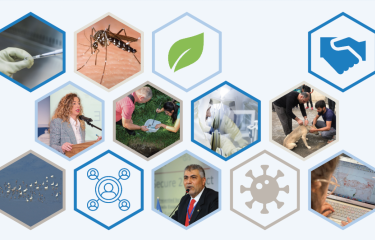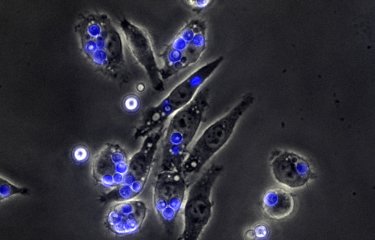Like every year since 2013, the Institut Pasteur organized on December 11th a ceremony in honor of the young graduates who defended their PhD thesis during the 2016-2017 academic year. The 2017 edition honored 34 young Pasteurian scientists, 5 of whom completed their thesis in an institution member of the Institut Pasteur International Network.
"We are pleased and proud to welcome these young graduates to the Institut Pasteur campus. They embody the scientific vitality of the Network," said Marc Jouan, International Vice-President of the Institut Pasteur.
The five doctoral students carried out their work in the Institut Pasteur de la Guyane, Institut Pasteur de Madagascar, Institut Pasteur du Maroc, Institut Pasteur of Shanghai, Chinese Academy of Sciences and the Scientific Institute of Public Health in Brussels on topics as diverse as rabies, antibiotic resistance, HIV , the study of bat viruses’ or the sociology of health.
 Andry Herisoa ANDRIANASOLO - Tackling the challenge of access to care in Madagascar
Andry Herisoa ANDRIANASOLO - Tackling the challenge of access to care in Madagascar
PhD in Sociology and Demography
Socio-anthropology team, Epidemiology Unit, Institut Pasteur de Madagascar
Georges Chevrier Center, University of Burgundy
Gender & Health Laboratory, Population and Development Center, Paris Descartes University.

Her work focused on the determinants of access to care in Madagascar. For this, she studied the behavior of populations and practices of health professionals in case of malaria, tuberculosis and acute respiratory infections. Her work showed that therapeutic abstention and self-medication were more frequent than recourse to health professionals, and that patients adopting one or the other of these practices differed significantly. In addition, she showed that patients' access to appropriate care depended on the representation and perception of the severity of the diseases, their costs, the availability of drugs and other inputs, the geographical health facilities, and the quality of care provision. These results highlight the challenges of universal health coverage in Madagascar, such as the fight against malaria and tuberculosis despite their international support. Andry now wishes to pursue her career in the fields of business, research, and action in public health or for development.
This thesis work has been supported by the Institut de Recherche pour le Développement, the Mérieux Foundation and the Institut Pasteur de Madagascar.
 Lucie BRACQ - Dissemination of HIV-1 by multinucleated giant cells
Lucie BRACQ - Dissemination of HIV-1 by multinucleated giant cells
PhD in Virology
Antiviral Immunity and Genetic Therapy Unit, Institut Pasteur of Shanghai - Chinese Academy of Sciences
Virus and intracellular trafficking, Institut Cochin (Paris)

The research carried out by Lucie Bracq were jointly supervised by Serge Benichou's at the Institut Cochin in Paris and Paul Zhou at the Institut Pasteur of Shanghai – Chinese Academy of Sciences. The human immunodeficiency virus (HIV) targets immune system cells such as macrophages, lymphocytes and dendritic cells. These cells can be infected with free virus but their infection by close contact with an infected donor cell is largely more effective and relevant in vivo. However, the mechanism of transmission of HIV-1 to macrophages by an infected T-cell remains poorly understood. Thanks to a grant from the Institut Pasteur International Network, the thesis of Lucie Bracq has highlighted a new model of macrophage infection by a two-stage cell fusion process. The infected T cells are able to fuse with the target macrophages, forming an infected hybrid cell, itself capable of fusing with surrounding macrophages and leading to the formation of infected multinucleate giant cells capable of producing significant amounts of infectious virus and survive the cytopathic effects of HIV-1. This mechanism brings new insights into the understanding of macrophage infection and the formation of viral reservoirs present especially in the brain of infected patients. Lucie Bracq will continue her work as a postdoctoral fellow at the Institut Pasteur of Shanghai – Chinese Academy of Sciences, beginning in 2018, in the Viral Diseases and Vaccines Translational research Unit.
This PhD was co-financed by a doctoral grant Calmette & Yersin from the Institut Pasteur Department of International Affairs and by the University of the Chinese Academy of Sciences (UCAS).
 Kaotar NAYME - Foods: Antibiotic Resistance Gene Pool?
Kaotar NAYME - Foods: Antibiotic Resistance Gene Pool?
PhD in Health Sciences specialized in Microbiology - Molecular Biology
Laboratory of Molecular Bacteriology, Institut Pasteur du Maroc

Her PhD work aimed to better understand the role of food in the spread of antibiotic resistance. The young researcher studied 352 strains of Escherichia coli from food sources, some of which are pathogenic and lead to poisoning. The study of the antibiotic susceptibility of these strains revealed a significant resistance to antibiotics of medical interest such as quinolones and betalactamines. Several clones, circulating in food in Morocco, have thus been identified and the genetic origin of their resistance characterized. This entire study reveals the importance of implementing evolutionary tools to monitor the antibiotic resistance in bacteria to optimize the effectiveness of the available therapeutic arsenal. Kaotar is a researcher in the Laboratory of Molecular Bacteriology of the Institut Pasteur du Maroc. She continues her work on the identification of antibiotic-resistant bacterial strains and their genetic characterization.
The work of this thesis was funded by the Institut Pasteur du Maroc.
 Arielle SALMIER - Bats, reservoirs of emerging viruses!
Arielle SALMIER - Bats, reservoirs of emerging viruses!
PhD Physiology and Biology of organisms, populations and interactions
Laboratory of Virus-Host Interactions, Institut Pasteur de la Guyane

Bats are privileged reservoirs of many viruses, some of which are responsible for severe diseases in humans (rabies, SARS, Ebola, etc.). In French Guiana, where 106 species have been recorded, little data is available on the viral diversity they harbor. Arielle's thesis project aimed to characterize the viral diversity of three species of bats (frugivorous, insectivorous and hematophagous) and to study the genetic diversity of these species using mitochondrial (neutral) and immune (functional) markers. She highlighted a significant viral diversity in the individuals studied, characteristic of the diet and the habitat. The study of demographic history (neutral markers) revealed a genetic structuring of vampire bat populations, not observed for the two-other species studied. The study of the functional history allowed her to show a potential of specific adaptation of the micro-environment for the three species of bats. These results provide fundamental data on circulating viruses in bat communities in French Guiana; necessary for the establishment of a surveillance program for emerging zoonoses. Arielle is currently working on the characterization of viral diversity in two migratory bird species in the Virus-Host Interactions laboratory at the Institut Pasteur de la Guyane.
To carry out her work, Arielle benefited from a European grant and an "Investissement d'Avenir" grant managed by the French National Research Agency.
 Sanne TERRYN - Using camelids in the fight against rabies
Sanne TERRYN - Using camelids in the fight against rabies
Doctorat en médecine vétérinaire
Département des maladies virales, Institut scientifique de santé publique (Bruxelles)
Département de Virologie, Université de Gand (Gand)
Currently, post-exposure prophylaxis against rabies consists of anti-rabies vaccination combined with the administration of rabies immunogloblins. This latter is a solution of anti-rabies antibodies purified from the blood of people vaccinated against rabies. Because of the high costs associated with the purification process, the product is often unavailable in areas were rabies is still endemic and were people need it the most. During here PhD, Sanne investigated the potential of single domain antibodies for the prophylaxis and treatment of rabies using mouse models. Single domain antibodies are small antibody fragments derived from heavy chain antibodies present in members of the camelid family. Thanks to their small size and simple architecture, these fragments can easily be produced in bacteria and yeasts. She was able to show that these single domain antibodies, could not only potently neutralize the virus in an in vitro setting, but could also prevent disease in mice. When they were administered in a post-exposure setting, the protective effect of single domain antibodies could be improved by prolonging the half-life and by combining them with vaccination. Since these single domain antibodies can be produced in yeast and bacterial expression system, the production costs are lower compared to the production of immunoglobulins. The development of single domain antibodies as an alternative rabies immunoglobulins, might therefore result in a treatment that is easier accessible to the people most at risk. Currently she continues working on research projects on the rabies virus and works as the scientist at the Reference Laboratory for rabies at the Scientific Institute of Public Health in Brussels.
Sanne Terryn received a fellowship from the Scientific Institute of Public Health in Brussels.
Copyright photos Institut Pasteur/Thomas Lang






